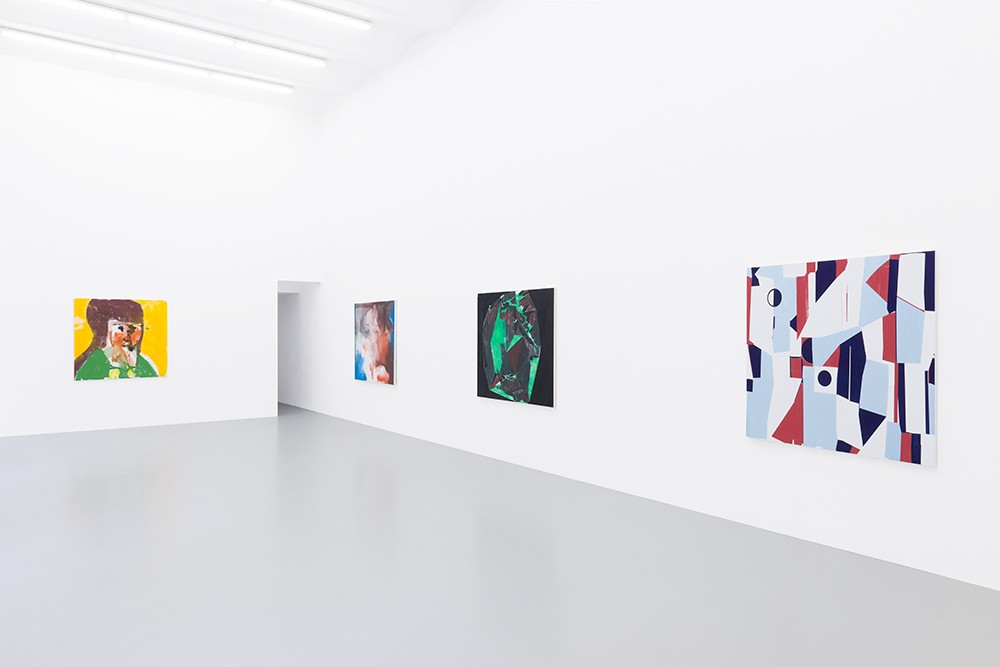Martina Steckholzer
Clarice
08 Mar - 27 Apr 2017
MARTINA STECKHOLZER
Clarice
8 March – 27 April 2017
Martina Steckholzer's post-conceptual paintings are produced according to a predetermined “method” or idea. She photographs or films art works and environments that appeal to her at art fairs and exhibitions. After selecting the images she likes, she paints them in “any-style-whatever,” rendering her conceptual framework “invisible.” Her paintings nevertheless share a light and deliciously off-hand manner, a sumptuous and precise “badness.”
Style is not the point, or rather, style not being the point is the point, because it renders the painting’s conceptual frame in the negative. The frame seems to frame its own absence. As a result, the idea does not determine its object, while remaining its condition. Most simply the conceptual frame is technical – digital photography. Photography was originally supposed to replace (and significantly improve) the representational function of painting, thereby pushing painting towards abstraction. In fact, however, photography’s “mechanical eye” has become integral to contemporary art, painting included, because it does not recognise art, or even beauty, and offers an aesthetic indifference art uses in its perpetual quest to escape itself, to become “non-art.” Steckholzer’s work, however, seems to move in exactly the opposite direction, using photography to fragment, isolate, and distort its original, and making it part of the process of modern painting.
The paintings do not try to “represent” their objects, even though their “concept” employs representational technology, because this element is erased through its actualisation. The conceptual frame of the work (ie., the digital reproduction of existing art works) seems to directly contradict the visual content of the paintings (various painting codes), making the latter negate the former. The paintings are therefore liberated copies, free of their conceptual frame, but reliant upon it. They embody a dialectical logic of “de-figuration,” reproducing their objects in a way that denies the representational function of their mechanism. As a result, Steckholzer’s paintings pass through the technological apparatus, or “format” that conditions them (not to mention the “format” of contemporary art, but that’s another story), while negating its representational veracity in favour of its distortions, its mutational potentials. But they do so within the semantic limits of the modernist styles they inhabit, which supply the conditions of these transformations. These categorical restrictions of pre-existing modernist styles allow Steckholzer to affirm “painting,” while avoiding any utopian or naive dreams of its absolute “freedom,” or as a pure “outside.” Consequently, they have an intelligent feeling.
Stephen Zepke, 2017
Clarice
8 March – 27 April 2017
Martina Steckholzer's post-conceptual paintings are produced according to a predetermined “method” or idea. She photographs or films art works and environments that appeal to her at art fairs and exhibitions. After selecting the images she likes, she paints them in “any-style-whatever,” rendering her conceptual framework “invisible.” Her paintings nevertheless share a light and deliciously off-hand manner, a sumptuous and precise “badness.”
Style is not the point, or rather, style not being the point is the point, because it renders the painting’s conceptual frame in the negative. The frame seems to frame its own absence. As a result, the idea does not determine its object, while remaining its condition. Most simply the conceptual frame is technical – digital photography. Photography was originally supposed to replace (and significantly improve) the representational function of painting, thereby pushing painting towards abstraction. In fact, however, photography’s “mechanical eye” has become integral to contemporary art, painting included, because it does not recognise art, or even beauty, and offers an aesthetic indifference art uses in its perpetual quest to escape itself, to become “non-art.” Steckholzer’s work, however, seems to move in exactly the opposite direction, using photography to fragment, isolate, and distort its original, and making it part of the process of modern painting.
The paintings do not try to “represent” their objects, even though their “concept” employs representational technology, because this element is erased through its actualisation. The conceptual frame of the work (ie., the digital reproduction of existing art works) seems to directly contradict the visual content of the paintings (various painting codes), making the latter negate the former. The paintings are therefore liberated copies, free of their conceptual frame, but reliant upon it. They embody a dialectical logic of “de-figuration,” reproducing their objects in a way that denies the representational function of their mechanism. As a result, Steckholzer’s paintings pass through the technological apparatus, or “format” that conditions them (not to mention the “format” of contemporary art, but that’s another story), while negating its representational veracity in favour of its distortions, its mutational potentials. But they do so within the semantic limits of the modernist styles they inhabit, which supply the conditions of these transformations. These categorical restrictions of pre-existing modernist styles allow Steckholzer to affirm “painting,” while avoiding any utopian or naive dreams of its absolute “freedom,” or as a pure “outside.” Consequently, they have an intelligent feeling.
Stephen Zepke, 2017

